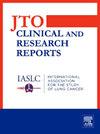Combination of Lurbinectedin and Osimertinib for Treatment of EGFR-Mutated Transformed SCLC: A Brief Report
IF 3.5
Q2 ONCOLOGY
引用次数: 0
Abstract
Third-generation tyrosine kinase inhibitors are effective treatment of EGFR-mutated NSCLC. After an initial response, patients on this therapy ultimately develop resistance leading to disease progression. One of the resistance mechanisms is histological transformation to SCLC. There is no standard of care for the management of transformed SCLC. Given the rarity of transformed SCLC, it is important to study treatment options that are safe and effective for this disease. In this case series, three patients received treatment with lurbinectedin plus osimertinib after transformation to SCLC. In our limited experience, the combination was found to be safe.
鲁贝替尼(Lurbinectedin)与奥西莫替尼(Osimertinib)联合治疗表皮生长因子受体突变的转化型SCLC:简要报告
第三代酪氨酸激酶抑制剂可有效治疗表皮生长因子受体突变的非小细胞肺癌。经过最初的应答后,接受这种疗法的患者最终会产生耐药性,导致疾病进展。耐药机制之一是组织学转化为 SCLC。目前还没有治疗转化型 SCLC 的标准疗法。鉴于转化型SCLC的罕见性,研究对这种疾病安全有效的治疗方案非常重要。在本病例系列中,有三位患者在转化为SCLC后接受了鲁贝替尼加奥希替尼的治疗。在我们有限的经验中,发现这种联合疗法是安全的。
本文章由计算机程序翻译,如有差异,请以英文原文为准。
求助全文
约1分钟内获得全文
求助全文
来源期刊

JTO Clinical and Research Reports
Medicine-Oncology
CiteScore
4.20
自引率
0.00%
发文量
145
审稿时长
19 weeks
 求助内容:
求助内容: 应助结果提醒方式:
应助结果提醒方式:


